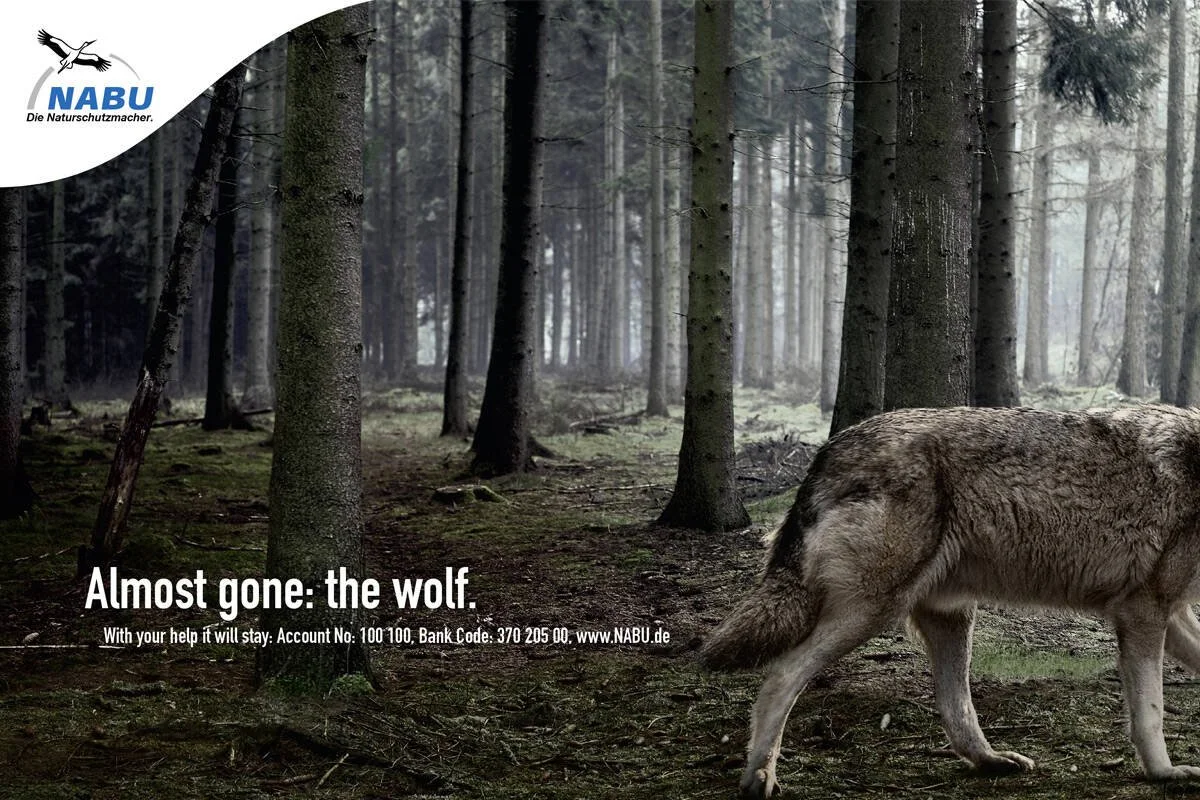The Role of Graphic Design in Environmental Activism
NABU campaign titled 'Wolf, Tree frog, Cod' (2009) | Image Source: www.adsoftheworld.com (17.10.2025)
Environmental activism has many voices. Some shout through protests, some write policy, some plant trees. Graphic designers do something different—they translate urgency into visuals people can’t ignore. Whether it’s a poster held up at a climate march or an eco label on product packaging, design shapes the way people feel about environmental issues long before they decide to take action.
Why Visuals Matter When Facts Aren’t Enough
Most people already know the planet is in trouble. Melting ice caps and rising sea levels are familiar headlines. The problem isn’t awareness—it’s engagement. Statistics alone rarely motivate change, but a well-crafted visual can. It takes abstract data and turns it into something that speaks directly to instinct rather than intellect. A poster showing a turtle tangled in plastic does more than a paragraph explaining ocean waste tonnage. A logo with intentional simplicity and earthy restraint signals responsibility without shouting it. Design bypasses resistance and reaches people faster than any carefully worded explanation.
Design as a Form of Advocacy
Environmental messaging doesn’t always come from activist groups. Brands now play a major role, whether they intend to or not. Every label, ad, and social post speaks volumes about what that company prioritises. Some use design to make sustainability part of their identity. Others use it to disguise the absence of meaningful effort. That’s where designers face a choice. The same tools that can build trust can also be used to imitate it. True advocacy in design happens not just through visuals, but through responsible decision-making behind those visuals. Choosing recycled paper is as important as the typography printed on it. Declining a project that exists purely to polish a harmful product is sometimes the most powerful design decision of all.
When Campaigns Get It Right
There are plenty of examples of environmental design done well—not because they look “green,” but because they communicate clearly without overpromising. Patagonia is a consistent reference point for a reason. Their visuals match their ethics. Their campaigns are restrained, direct and honest. They rarely use nature imagery for decoration. Instead, they let typography and layout carry the message with quiet confidence. Another strong example is Extinction Rebellion, whose visual identity is deliberately raw and unpolished. Hand-drawn fonts, high-contrast symbols and limited colour palettes make the message feel urgent and human rather than corporate. The irregularity is part of the appeal. It invites participation. The WWF goes in the opposite direction with soft minimalism. The panda logo is instantly recognisable not because it is loud, but because it is deceptively simple. These differing approaches share one thing: design that fits the tone of the movement rather than overshadowing it.
Patagonia’s anti-marketing campaign to discourage customers from buying new Patagonia products and suggests they get existing items repaired instead | Image Source: ©Patagonia
Beyond Awareness: Supporting Sustainable Habits
Effective environmental design doesn’t just raise awareness; it removes friction from better choices. Clear recycling icons on packaging, refill-friendly labelling, modular system diagrams that make reusing feel intuitive—these are all examples of design used not as a billboard but as quiet guidance. A sustainability message on a poster may earn applause, but an instruction that makes sustainable behaviour easier earns results. Designers who understand user behaviour can build sustainability into everyday routines without asking for extra effort. The less moralising involved, the more likely people are to comply.
The Materials Matter as Much as the Message
The debate around green aesthetics often ignores the physical layer. Print is still powerful in activism, but wasteful printing undermines the message instantly. Designers now face decisions that go beyond CMYK. Is this poster better delivered digitally? If printed, should it use soy-based ink? Can the size be reduced to minimise paper waste without sacrificing clarity? Sustainability doesn’t need to be announced every time—it can be quietly built into production. The more designers normalise it, the less it becomes a marketing bullet point and the more it becomes standard practice.
Chilean brand ‘Algramo’ invented refill stations for household products | Image Source: www.inkbotdesign.com (17.10.2025)
Working With Authenticity Instead of Aesthetic Tropes
Environmental visuals often fall into the same tropes—soft greens, hand-drawn leaves, gentle gradients, globe icons. They have their place, but overuse dilutes their impact. Audiences have become fluent in identifying “eco-lookalikes” used more for appearance than sincerity. Authenticity shows up not just in what is shown, but what is avoided. Some issues demand restraint rather than decoration. Some campaigns benefit from bold abstraction instead of literal nature motifs. The aim isn’t to look sustainable—it’s to communicate responsibility without resorting to the visual clichés that now border on parody.
When Design Becomes a Catalyst Instead of Decoration
There is a clear difference between design that supports a message and design that merely decorates it. A poster saying “Save the Earth” with a photo of a mountain is decoration. A campaign that points to a specific behaviour change, policy shift or action step is communication. Design earns its relevance in environmental activism when it does more than exist—it guides, informs and persuades. If the viewer leaves with something actionable rather than just something pleasing, then the design has done its job.
The Designer’s Responsibility in a Changing Industry
Graphic design is no longer confined to making things look good. It has evolved into a role that balances aesthetics, ethics and usability. Designers have influence—whether they acknowledge it or not. Every colour, typeface and composition feeds perception. When used thoughtfully, these choices can soften resistance, encourage participation and build trust. Not every project has to be overtly activist to contribute. Sometimes it’s as simple as pushing a brand towards recycled packaging or simplifying information so that environmental benefits are communicated clearly.
Environmental change relies on communication, and communication relies on design that people actually absorb. Not every designer needs to lead a climate campaign, but every designer holds the ability to make responsible messages more visible and understandable. When visuals align with values, audiences respond. And if you’re working on a sustainability-focused project and need support from someone who understands both aesthetics and integrity, I’m available to help shape the message into something that speaks clearly—without resorting to overused green leaves and planet icons.






